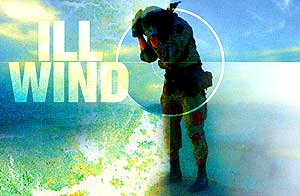
| ||
|
|
As another Middle East conflict dies down, veterans and doctors say the previous round’s biowarfare casualties remain mysteriously ignored
By Thomas G. Whittle & Linda Amato
 More than a dozen years after Desert Storm, Gulf War Illness’ biological factor still plagues veterans and their loved ones – a bitter harvest for our victorious forces and an ongoing tragedy for their loved ones.
More than a dozen years after Desert Storm, Gulf War Illness’ biological factor still plagues veterans and their loved ones – a bitter harvest for our victorious forces and an ongoing tragedy for their loved ones.
Janyce longed to be a mother, to raise children and see them prosper. In 1994, she married Arvid Brown, and was elated when she learned a child was on the way. When Asa was born the following year, Janyce raised him with a loving heart, swallowing her feelings about his problems.
With only one in 28 babies in America born with some type of physical defect, odds were that their next child would be healthy. But when daughter Helen entered the world in 1997, she was multiply disabled. Asa, then 3, remained unable to talk and had trouble using his hands.
Compounding the situation, Arvid also suffered from debilitating ailments. His symptoms had first appeared during the Persian Gulf War, while serving at the 301st Military Police Prisoner of War Camp near Hafir Al Batin in Saudi Arabia. The day he arrived there in 1991, chemical weapon alarms sounded as Scud missiles rained. By the end of his Gulf tour, Arvid’s ailments included rashes, diarrhea, headaches, nausea and vomiting. And as bad as that was, his condition deteriorated further after returning to Michigan.
“I experienced pains so incomprehensible that I would pass out,” he told Freedom. “I had photophobia [extreme sensitivity to light] and heat intolerance that prevented me from going outside. I experienced loss of orientation, blurred vision, tremors and other neurological signs and symptoms,” including loss of balance and memory.
Fever and bone pain extended to every part of his body. Night brought no relief as sweats, chills and other symptoms combined to make sleeping difficult, sometimes impossible.
Janyce, healthy prior to marrying Arvid, developed serious physical problems similar to her husband’s. “Chemicals are not contagious,” she said, drawing her own conclusion that biological toxins to which Arvid was exposed in the Persian Gulf must have been transmitted to her.
Her belief was borne out by, among other indications, medical tests that showed all four family members had leishmaniasis, a sometimes fatal disease normally spread by sand flies in the Persian Gulf and other desert regions — one of the contagious illnesses afflicting veterans who served in the Gulf War.
 Saddam Looks for “Novel Ways to Kill”
Saddam Looks for “Novel Ways to Kill”
|
Chemical weapons are, of course, chemicals. They include nerve gas, mustard gas, cyanide, tear gas and other substances. While toxic, they are not contagious.
“The thing that I can say with a high degree of confidence about Saddam Hussein and about his programs, his chemical-biological weapons programs especially,” Patrick Eddington, former CIA analyst and author of Gassed in the Gulf, told Freedom, “is that they were always looking for novel ways to kill people. And to kill them slowly, often-times, if at all possible, in order to increase their suffering.”
Eddington observed that Saddam’s style is to make people suffer. The chemical and biological toxins alleged to be in Saddam’s inventory since the days of the Iran-Iraq War (1980–1988) constitute the most lethal substances known to man, including mutated forms of virulent germs. In addition, Iraqi forces have combined chemical and biological weapons, as in 1988, when they mixed aflatoxin, a biological agent known to cause cancer, with riot gases and used them against the Kurds with deadly effect.2
The possibility of chemical warfare contamination of Gulf veterans was repeatedly denied by Pentagon spokespersons from the onset of soldier complaints in 1991. However, in the midst of an intensified investigation of the problem by Freedom in 1996, with evidence of chemical weapons contamination mounting to the point of being irrefutable, the Defense Department admitted exposure of American forces to Iraqi chemical agents.3
Since then, the numerous cases of illness passed from veterans to spouses, children and even household pets, according to experts interviewed by Freedom, continues to present the specter of Gulf War Illness’ biological factor — a bitter harvest for the victorious forces and an ongoing tragedy for their loved ones.
Apparent Cause —Neglected Cure
Garth Nicolson, Ph.D., and his wife, Nancy Nicolson, Ph.D., initially conducted research into Gulf War Illness at the M.D. Anderson Cancer Center at the University of Texas in Houston. There, the Nicolsons isolated an apparent cause of sick veterans’ symptoms in a possible component of a Saddam biological cocktail — the microorganism known as Mycoplasma fermentans incognitus (MFI), which can cause protracted illness and a lingering death.
The Nicolsons’ studies have shown that approximately 40 percent of veterans complaining of Gulf War Illness symptoms have mycoplasma in their bodies. And roughly 80 percent of those have the rare MFI — a strain harbored by only about 1 percent of the general population, according to Garth Nicolson. Ironically, MFI was patented by Shyh-Ching Lo, M.D., then a researcher at the Armed Forces Institute of Pathology, now chief of the institute’s Division of Molecular Pathobiology.
The Nicolsons served as consultants to physicians treating veterans, with many of their first clients from America’s premier fighting organizations, such as the Army’s Special Forces and Delta Force and the Navy’s SEALs. But soon they found themselves helping to treat veterans’ spouses and children.
In their ongoing research and efforts to assist veterans at the Institute for Molecular Medicine in Huntington Beach, California, the Nicolsons have been consulted in the treatment of thousands of Gulf veterans and their family members.
According to Garth Nicolson, the institute’s president, roughly 80 percent responded favorably to a regimen that included vitamins and antibiotics, particularly doxycycline.
Sick Gulf veterans learned, however, that some doctors serving the armed forces and the Department of Veteran Affairs (VA) refused to acknowledge the effectiveness of doxycycline. As one retired Special Forces officer pointed out, “I got my blood sent to Dr. [Garth] Nicolson for free testing and got my prescription for doxycycline. I went to have it filled and not only did they take away my military ID card, but they would not allow me to have the doxycycline to save my life.”4
Evidence of Physical Injury
In 1997, Arvid Brown lost his job, physically unable to meet his employer’s standards. And he could not find a doctor able to explain his condition—or his children’s. But as more and more Gulf veterans stepped forward with similar reports, Brown realized that he had contracted something communicable — a form of what has become known as Gulf War Illness — and passed it on unwittingly to his family.
While bureaucrats waffled about the mounting evidence of illness and doctors “studied” the matter, veterans’ problems only intensified.
In 1998, when Arvid and Janyce Brown went outside the VA system to a private clinic and all four family members tested positive for leishmaniasis, they knew they had found at least part of the answer.
Forms of leishmania — the group of parasitic microorganisms that cause the illness — were apparently suspected by UN inspectors to be in Saddam’s inventory.5 Yet, to this day, more than a dozen years after Desert Storm, Arvid and many other veterans have been unable to obtain adequate medical assistance for symptoms caused by biological means, including possible biological warfare agents, or by chemical agents and toxins, despite evidence of physical damage.
Studies documenting physical injury include those conducted by researchers at the University of Texas Southwestern Medical Center at Dallas. Headed by Robert Haley, M.D., this team showed conclusively that sick Gulf veterans sustained brain damage. Corresponding with the regions injured, “UT Southwestern researchers identified a syndrome characterized by thought, memory and sleep difficulties; a second syndrome that involves more severe thought problems as well as confusion and imbalance; and a third syndrome of sore joints and muscles and tingling or numbness in the hands and feet.”6
Researchers linked the damage to multiple chemical exposures: chemical warfare agents, anti-nerve gas tablets, pesticides and insect repellents. Continuing their research, they subsequently found that Gulf veterans complaining of dizziness also experienced brain damage.7


